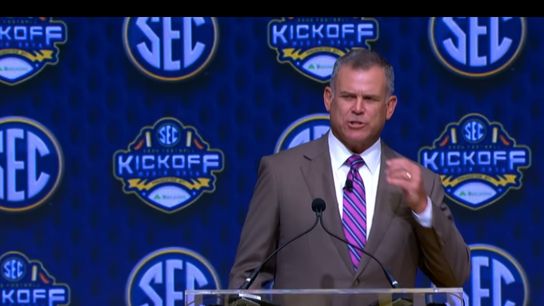The first-ever revenue-sharing college football season, the second-ever 12-team College Football Playoff and the ongoing NCAA Transfer Portal era hardly are the only changes: get ready for defensive false starts.
John McDaid, the Southeastern Conference's coordinator of officials, outlined a number of the sport's new rules for the coming season, but the onset of "defensive false starts" comes, he said, after a 100 years of that expected discipline on the offensive side of the ball.
McDaid explained how the defensive false start, which officially will be termed defensive delay of game, will work:
"The definition of a false start has forever been action that simulates the snap," McDaid told reporters Tuesday in Atlanta at the SEC's annual media bonanza. "That's standard, action that simulates the snap is now put on the defense as well, and the officials are being asked to judge defensive movement in that light.
"We're going to watch this defensive tackle [via video presentation] that's lined up between the right tackle and the right guard, and you're going to see he has two down teammates to our left of him, for what football coaches do call stemming. That action by the two that are stemming on our left, legal, but you can see in concert with that, we have a tackle between the right guard and right tackle who's flinching. He's simulating action at the snap, and it works. It makes the right guard move here.
"This is action that has now been written into the rules, codified that it's illegal, it's what we call delay of game defense. This is not a false start on the offense. The defense cannot simulate action of a snap for the purpose of trying to get his opponent to move prior to the snap."
McDaid also provided more insight into the ongoing debate surrounding substitutions, particularly on the defensive side of the ball, and the sixth-year SEC officiating boss also elaborated on conversations among officials that regarded interpreting defenses trying to "game" the play-clock as an impediment to the offense:
"We go into what we call substitution mechanics. You'll see the mechanics when the referee is going into this position right here, and it starts off signifying that the offense is substituted, and once the offense has declared the 11, he's going to look over to the defensive sideline and give him a three-second window for the defense to match up substitute.
"What we've seen over the last couple years -- and we definitely saw it at a high volume or a higher volume in the 2024 postseason -- is defenses are starting to try to game how they're doing their match-up substitutions and trying to eat up the play clock. So we're adding the concept of the substitutions need to be done with an athletic pace.
"The standard has always been the defense must substitute promptly. That was the standard that we need to interpret for our judgment on what the defense is doing. We're adding now that they need to do it at an athletic pace.
"We're going to watch this substitution by the defense here, and you'll see a couple things. Maybe or maybe not an athletic pace being used by not only the substitute coming onto the field but the player that's being replaced going off the field. But there's also something else going on. We're going to watch the change between -- let's go to the beginning of the clip. The change between the interior defensive linemen, how long it takes to identify who the replaced players are going to be.
And what we're asking our teams to do is the match-up substitution rules are such that the defense needs to start their substitution within three seconds of the offense declaring their 11 players for the next snap. The replaced players need to be identified in that window as well.
What are we going to do if this happens? And we do it in this game. Watch the center judge. He's the official right behind the center. If we deem the defensive substitution is not with athletic pace and it's not being done promptly, we're going to simply take the center judge off the ball like we're doing here, and now the offense is free to snap the ball, and the defense may or may not have 11 players on the field when the ball is snapped.
More from McDaid can be found in this video in which he detailed the numerous and most prominent rule adjustments, changes and new rules in Atlanta:
